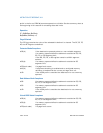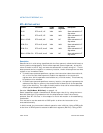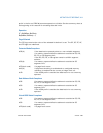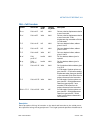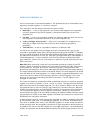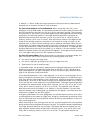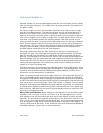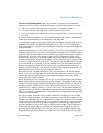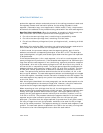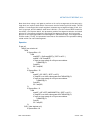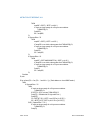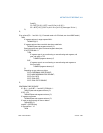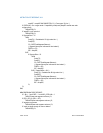
3-90 Vol. 2A CALL—Call Procedure
INSTRUCTION SET REFERENCE, A-M
segment selector for the new code segment and the new instruction pointer (offset)
from the call gate descriptor. (The offset from the target operand is ignored when a
call gate is used.)
On inter-privilege-level calls, the processor switches to the stack for the privilege
level of the called procedure. The segment selector for the new stack segment is
specified in the TSS for the currently running task. The branch to the new code
segment occurs after the stack switch. (Note that when using a call gate to perform
a far call to a segment at the same privilege level, no stack switch occurs.) On the
new stack, the processor pushes the segment selector and stack pointer for the
calling procedure’s stack, an optional set of parameters from the calling procedures
stack, and the segment selector and instruction pointer for the calling procedure’s
code segment. (A value in the call gate descriptor determines how many parameters
to copy to the new stack.) Finally, the processor branches to the address of the
procedure being called within the new code segment.
Executing a task switch with the CALL instruction is similar to executing a call
through a call gate. The target operand specifies the segment selector of the task
gate for the new task activated by the switch (the offset in the target operand is
ignored). The task gate in turn points to the TSS for the new task, which contains the
segment selectors for the task’s code and stack segments. Note that the TSS also
contains the EIP value for the next instruction that was to be executed before the
calling task was suspended. This instruction pointer value is loaded into the EIP
register to re-start the calling task.
The CALL instruction can also specify the segment selector of the TSS directly, which
eliminates the indirection of the task gate. See Chapter 6, “Task Management,” in the
Intel® 64 and IA-32 Architectures Software Developer’s Manual, Volume 3A, for
information on the mechanics of a task switch.
When you execute at task switch with a CALL instruction, the nested task flag (NT) is
set in the EFLAGS register and the new TSS’s previous task link field is loaded with
the old task’s TSS selector. Code is expected to suspend this nested task by executing
an IRET instruction which, because the NT flag is set, automatically uses the previous
task link to return to the calling task. (See “Task Linking” in Chapter 6 of the Intel®
64 and IA-32 Architectures Software Developer’s Manual, Volume 3A, for information
on nested tasks.) Switching tasks with the CALL instruction differs in this regard from
JMP instruction. JMP does not set the NT flag and therefore does not expect an IRET
instruction to suspend the task.
Mixing 16-Bit and 32-Bit Calls. When making far calls between 16-bit and 32-bit code
segments, use a call gate. If the far call is from a 32-bit code segment to a 16-bit
code segment, the call should be made from the first 64 KBytes of the 32-bit code
segment. This is because the operand-size attribute of the instruction is set to 16, so
only a 16-bit return address offset can be saved. Also, the call should be made using
a 16-bit call gate so that 16-bit values can be pushed on the stack. See Chapter 16,
“Mixing 16-Bit and 32-Bit Code,” in the Intel® 64 and IA-32 Architectures Software
Developer’s Manual, Volume 3A, for more information.



